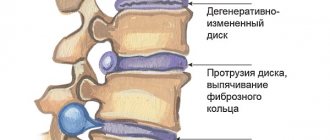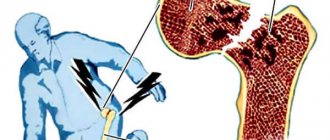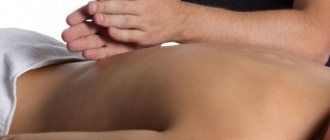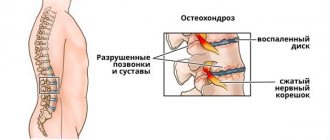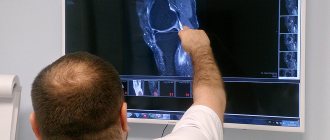Disability due to osteochondrosis.
Osteochondrosis is a severe recurrent degenerative-destructive pathology that affects vertebral bone and cartilage structures. In the absence of medical intervention, irreversible complications develop that do not allow the patient to lead a normal lifestyle. Limited mobility, constant or occasional severe back pain is the reason for the inability to attend work. Therefore, patients with high-grade osteochondrosis ask doctors: is this pathology a disability?
CT scan of the lumbar spine for osteochondrosis.
Criteria
MSEC takes into account social activity, help from relatives, and other sources of income, so it is difficult to predict its decision. However, there are certain medical criteria that make assignment of a disability group very likely. Depending on the size and direction of the intervertebral hernia, the presence of serious complications and concomitant diseases, the first, second or third disability group is given.
Each of them has its own benefits and prohibitions. Do not forget that establishing a disability group imposes restrictions on professional activities. In the case of the first or second group, work in the main specialty is officially impossible.
However, it is extremely rare that a patient is recognized as disabled for a long time or for the rest of his life. Usually he regularly undergoes re-examination, at which his group can be raised or lowered. With intervertebral hernias, a significant improvement in the condition after surgery is possible. In this situation, after a rehabilitation period, a person may be recognized as able to work.
Third group
The third disability group is the lightest. It allows you to continue your professional activities with certain restrictions. For intervertebral hernias of the spine, the third group is given in the following situations:
- Almost constant pain syndrome. The pain can be severe or moderate, but it is difficult to treat or requires constant use of non-steroidal anti-inflammatory drugs. Pain significantly impairs the quality of life and interferes with the performance of professional duties.
- Movements in the spinal column are moderately limited. A person can move independently, serve himself and perform certain work. But he is unable to cope with the full workload of his main profession.
- Frequent exacerbations. Intervertebral hernias are usually accompanied by radiculopathy - symptoms of nerve root entrapment. Exacerbations are usually short-lived, easily treatable, but require frequent sick leave.
- In the main specialty, work is almost impossible, but the patient can cope quite well with light work.
- Full self-service.
The third group of disability requires clinical observation by a local doctor and planned courses of treatment in a hospital if necessary. MSEC re-examinations for intervertebral hernias are carried out regularly.
Second group
The second disability group is given in more severe and prognostically unfavorable cases. Frequent exacerbations with long sick leave, ineffectiveness of surgical treatment - all these are grounds for receiving the second group. In addition, it can be given in the following situations:
- With constant and intense pain, which is poorly eliminated by non-steroidal anti-inflammatory drugs, anticonvulsants and antidepressants.
- With significant restriction of movements in the spinal column and arms or legs, development of stiffness, stiffness.
- When neurological symptoms appear - numbness of the skin, sensitivity disorders, changes in reflexes, decreased muscle strength.
If an intervertebral hernia, complicated by neurological disorders, does not allow the patient to engage in even light work, and he is on sick leave for a long time, this is a reason to contact the MSEC and receive a second disability group.
First group
This is the most difficult option when diagnosing an intervertebral hernia. Symptoms of compression of the nerve roots or spinal cord are so severe that the person becomes completely disabled.
His movements in the spinal column, arms, and legs are limited to a significant extent, and control over the functioning of the pelvic organs may be lost. As a rule, the patient is unable to move and care for himself. He needs care from others. Even the easiest work is impossible.
In such a situation, they usually give the first disability group. Where does the permanent disability process begin?
What decisions does the expert commission make?
Citizens become acquainted with the results of the work of the expert commission on the day of their application after a closed review of their health status and voting. Depending on the test results and based on professional discussion, the commission makes three conclusions.
First . The group is not awarded; the applicant is able to work and can earn his own living. He has adapted well to society; existing pathologies are not critical. The patient can take care of himself, there is no risk of a sharp exacerbation of the negative dynamics of the disease.
A disability group may not be awarded
Second . The actual condition of the patient does not allow him to work; he is deprived of sources of material resources to meet his needs. There is no chance to retrain and get a job in a new specialty; big problems arise when servicing daily needs, including purely physiological ones. Modern medicine has no way to improve the patient’s condition; he needs government assistance.
Third . The health data available to the commission is not sufficient to make any decision. The citizen is notified of this situation and sent for additional examinations. The date for the final decision is postponed.
Disability is determined by the patient's condition
If you disagree with the conclusions of the medical and social examination, the patient can write a complaint to higher authorities. The letter must be accompanied by all currently available examination and test results, a medical record and other available documents.
Stages of the disease
Currently in medicine there are 4 stages of osteochondrosis:
- First (also known as preclinical). Since there are no destructive changes in the discs, the disease brings virtually no discomfort to its owner. Despite the fact that compactions are already appearing in the cartilaginous tissues, the spinal column functions properly and does not lose its shock-absorbing properties. The only thing that the patient will feel is fatigue, mild pain and slight lumbago when turning the head (if the disease has affected the cervical spine).
- Second. Its main characteristic is the intensification of degenerative processes in the nucleus pulposus, which entail a deterioration in many metabolic processes. After a certain time, the cells begin to die, which in the later stages of the disease can cause complete destruction of the spinal column and disability of the patient. At this stage, the symptoms become more intense, the patient gets tired too quickly, and the back pain almost never goes away.
- Third. The tissue of the fibrous ring is almost completely destroyed. Pathological changes in the discs provoke improper distribution of collagen fibers. Because of this, cracks and tears appear in the fibrous ring. In medicine, this process is called protrusion. It causes deterioration of the attachment of the vertebral bodies and causes their excessive mobility. Such changes can provoke subluxations and displacement of the lumbar vertebrae.
- Fourth. Tissue death and degenerative processes affect the ligaments and most of the structures of the spine. Fibrous tissue replaces the nucleus pulposus, the symptoms of the disease become pronounced, and the mobility of the spine is significantly reduced. Even with minimal movements, the patient begins to experience severe pain and tries not to move again.
Complications of osteoporosis
The most serious complications of osteoporosis include bone fractures, most often of the vertebrae or hip. Vertebral fractures with this disease can occur even without a fall. The consequence of a vertebral fracture is their deformation and disruption of the functioning of the damaged element of the spinal column. Displacement of a vertebra can result in compression of the spinal cord and lead to neurological pathologies.
Also, the course of osteoporosis can be fraught with complications in the form of poor posture.
In such cases, treatment is carried out - conservative (wearing a corset) or surgical (implantation of fixing metal structures).
Disability groups
In the first, most severe group of disability, the patient finds himself in a very difficult situation, movements are partially or completely limited, pain is severe and prolonged. Medication is aimed only at relieving negative feelings; treatment of the disease itself is ineffective and is not carried out. Very often, patients need constant care; they are unable to move and meet the needs of life. The first group is rarely determined and only in cases of very deep paraparesis or paraplegia due to compression of the cauda equina. Such pathologies cause third degree limitation of motor abilities.
Disability groups
Citizens with the second group have short periods of relief. But over time, their duration decreases, the intensity of the development of pathology increases. A re-passing of the MSEC is required to clarify the actual condition and change the disability group. Restrictions on second-stage movements and disability may occur temporarily after surgery or due to complications caused by laminectomy.
In the third group, work without stress on the spine is allowed. The patient has a chance to remain in a normal state for a relatively long period of time. If health indicators tend to improve, then the third group can be removed, a third is assigned instead of the second, and a second instead of the first. In reverse processes, repeated MSEC examination increases the disability group.
Definition of disability group 3
Documents and criteria for group assignment
The applicant will be required to:
— referral for examination;
— passport and SNILS;
- medical card (or extract).
The results of all diagnostic measures taken before undergoing the MSE are required. If a rehabilitation course has already been completed, you cannot do without describing it. A certificate of disability is needed for those to whom the group was assigned earlier.
Social and material status (for example, income level before illness) is examined. The severity of the condition, its causes and whether medical recommendations were violated are taken into account.
In addition, experts can ask what kind of relationship the patient has with his relatives, how he is able to do simple work, what kind of life he leads, how satisfied he is with the quality of his life, etc. That is, objective and subjective components play a role.
Most often, disability is granted for a year with subsequent re-examination. If your health improves during this time, your incapacity status may be lifted.
How to get a disability group for osteochondrosis
There are many ways to obtain a disability group for osteochondrosis. To assign benefits to the patient and assign disability status, a medical and sanitary expert commission (MSEC) meets. It determines the disability group, the period for issuing the status, the possibility of continuing to work or transferring the patient to another place of work, and further management tactics.
Most often, the MSEC for this pathology includes the following specialists: a vertebrologist, a neurologist, possibly a neurosurgeon, in rare cases a cardiologist, other specialists are possible depending on the clinical case of a particular patient. Based on extracts from the inpatient department, according to the notes of the attending physician and data from laboratory and instrumental studies, the patient’s current status is assessed. There are the following criteria on the basis of which status can be issued:
- Continuous cervicalgia lasting at least a week.
- Humeral arthritis for more than 4 months (see Arthritis of the shoulder joint).
- VBA syndrome, accompanied by frequent severe paroxysms of dizziness, observed for more than three days.
- Shoulder-hand syndrome with unproductive treatment for at least five months.
- Radicular syndromes in the lumbar and thoracic region with a duration of hospital treatment without much effect for more than two weeks.
- Exacerbation of lumbodynia syndrome for more than a week or lumbar ischalgia for more than two weeks.
- Operated patients with a long period of rehabilitation (temporary disability with further correction of work) or persistent residual effects.
How to get a disability group for osteochondrosis
The presence of a treatment protocol in a medical institution is not the basis for establishing a disability group. Even if the patient has one or more indications to determine his disability, a number of instrumental and biochemical studies are necessary. To confirm the diagnosis, the commission may require data on the state of health at the time of contacting the MSCE bureau. The examination results also make it possible to predict the development of cervical, thoracic or lumbosacral osteochondrosis.
Necessary examinations
In addition to the results of instrumental studies, clinical laboratory tests of blood and urine are performed to assess general health. Osteochondrosis is multi-etiological, therefore an interview with doctors of narrow specializations is necessary. For example, if the pathology has developed against the background of diabetes mellitus, then an endocrinologist’s opinion is required. A consultation with a neurosurgeon is also required, making a verdict on the advisability of the operation and the risk of complications.
| Instrumental research, which is carried out to determine disability in osteochondrosis | Diagnostic results |
| X-ray of the spine | The most informative study for identifying specific signs of osteochondrosis: reducing the distance between vertebrae, deformation of intervertebral discs, formation of bone growths (osteophytes) |
| CT (computed tomography) or MRI (magnetic resonance imaging) | Diagnostics are carried out to assess the condition of connective tissue structures located near the damaged segment of the spine. CT and MRI are also the most informative in identifying complications of osteochondrosis - protrusion, hernia |
| EMG (electromyography) | The study is carried out to identify the level of damage to the neuromuscular system, taking into account the functional and structural structure of the nervous system, identifying the severity of the damage, the dynamics of the process |
| RVG (rheovasography) or REG (rheoencephalography) | RVG or REG help to assess the intensity and volume of blood flow in the arterial vessels. This diagnostic procedure is most relevant for lumbosacral osteochondrosis |
| Myelography | X-ray contrast examination is indicated to determine the condition of the spinal cord. Myelography allows you to diagnose herniated intervertebral discs, chronic spinal arachnoiditis |
List of documents for passing MSEC
The attending physician will issue a list of required documents, as well as directions for examination. When contacting the MSCE bureau, the patient must have with him the results of instrumental (including x-ray images) and general clinical examinations with their interpretation. A preliminary conclusion on the definition of disability made by a council of doctors is required.
According to the procedure for determining disability, the patient must provide a passport and a copy of it to the regional department. If they are missing, any document that can be used to prove your identity will do. If the person is still working, proof of employment will be required. For this purpose, the personnel department issues a certified copy of the official registration. Non-working patients provide the MSCE department with a certificate of absence of a permanent place of work. Also, the list of documents required to determine disability includes the original SNILS along with a copy, and a sick leave certificate.
Conducting a medical and social examination
Having collected the necessary documentation, the patient must come to the regional department of MSKE within a certain period of time. It becomes known about it approximately a month from the date of filing the application. To establish incapacity for work, a commission of three department employees is assembled. They examine the patient, study the doctor’s report and the examination results that served as the basis for it. A survey of the applicant is also conducted to assess living conditions, his social skills, general well-being, the specifics of the course of osteochondrosis, and financial support. Bureau employees can inquire about professional skills, qualifications, and characteristics from the place of work.
List of additional special examinations
In some cases, it is very difficult to make an accurate diagnosis of a patient only on the basis of a treatment protocol from a medical institution. The commission has the right to request additional health data at the time of applying for disability. Such examinations make it possible to make a qualitative prognosis of the development of pathology.
- Radiography. The well-known, most common and traditional method for diagnosing the condition of the spinal column. Changes in bone tissue are most noticeable; soft tissue is not visible well enough. To study circulatory disorders and identify more complex pathologies in the form of neoplasms of various types, a contrast agent is injected into the patient’s blood. To obtain disability, you need to undergo an examination.
- Rheovasography and myelography. Special examinations of blood supply processes allow us to notice deviations in the development of the patient’s circulatory system. Before myelography, a contrast agent is injected with a long needle directly into the subarachnoid spinal canal. This is a rather complicated procedure, there is a risk of damage to nerve fibers. Examinations are performed only in specialized high-tech clinics with specialists of the appropriate level. Use of CT myelography.
- Rheoencephalography. Based on the information received, the commission has the opportunity to assess the state of the circulatory system, which is responsible for feeding brain cells. A modern device allows doctors to see in detail the actual condition of the vertebral artery.
- Electromyography. Examinations are prescribed for patients with radiculomyeloischemia syndrome. The data obtained indicate the size and groups of damaged corset muscles and identify pathologies of the nerve roots. These abnormalities in most cases cause severe pain.Electromyography (EMG)
- Magnetic resonance imaging. A diagnosis is made of the condition of the soft tissues adjacent to the spine. One of the most high-tech, accurate and safe examinations.
Before special examinations, a citizen must undergo an interview with highly specialized specialists and a neurosurgeon.
Magnetic resonance imaging
- X-rays of the spinal column are done by taking x-rays of the entire spine to determine what condition it is in and whether there are diseases that could negatively affect it.
- Rheovasography. Blood circulation processes are diagnosed to identify the presence of complications in the functioning of the spine due to improper blood circulation.
- Myelography. With its help, a contrast material is injected with a needle into the subarachnoid canal of the spine, and after that, images of the bones and nerve roots inside it are taken. This is carried out in order to know how much the disease has affected the spine.
- Rheoencephalography. It is used if a person has vertebral artery syndrome for the purpose of studying cerebral circulation.
- Electromyography is used for radiculomyeloischemia syndrome. It is done to determine whether there is damage to muscles and nerve tissue.
- Consultation with a neurosurgeon.
- A general blood test and urine test can help determine possible changes in the vertebrae.
- Magnetic resonance imaging. An analysis of the bone tissue of the spine and images of the spinal cord and brain are performed after the images are taken.
Step-by-step scheme for obtaining disability
It is quite possible for a person suffering from scoliosis to receive a disability, but for this it is necessary to collect all the necessary documents and confirm during the commission that the disease does not recede even if the therapy prescribed by the doctor is followed.
Collection of documents
At the first stage, you need to visit your doctor and tell him all your complaints. There is no need to remain silent about discomfort or ailments - all symptoms will subsequently be considered during the commission.
At the doctor
At the same stage, you should study the patient’s personal outpatient record. It should be sufficiently complete and reflect the dynamics of the disease. The doctors present at the commission will be interested in how the patient felt from the first visit to the clinic until the moment he submitted an application for a medical and social examination.
Patient's outpatient card
Passing examinations
To confirm the diagnosis, as well as identify possible concomitant diseases of the spine, it is necessary to undergo a series of medical procedures and studies. First, the patient is superficially examined by the attending physician, palpates the area of the spinal column and prescribes functional tests, including:
- blood donation for biochemistry and general analysis;
- donating urine;
- myelography of the diseased area;
- imaging diagnostics;
- spirometry to study the preservation of lung function;
- ECG.
Use of CT myelography
Imaging diagnostics can be performed using radiography (the panel will be interested in lateral and direct projections without contrast), magnetic resonance imaging or computed tomography. The last option is used most often, since this diagnostic method is accurate, informative, not very expensive and allows for a good examination of vertebral structures.
Diagnosis of scoliosis
When the examinations have been completed, you need to obtain opinions from doctors of several specializations: a neurologist, a pulmonologist and a cardiologist. They attach to the final conclusion a personal rehabilitation program, which is drawn up specifically taking into account the characteristics of the course of the disease in a particular patient. After this, you can proceed to applying for a medical and social examination. It is usually carried out by the state bureau of medical and social examination.
Conducting ITU
Passing the examination
All collected documents related to the disease must be submitted to the commission. The purpose of the medical and social commission is to make sure that the person applying for disability:
- complies with the recommendations given by the attending physician;
- did not provide false information about your health.
How a medical and social examination is carried out
The patient himself is not present when the decision is made.
As a result, a decision is made on the assignment of disability and its group, as well as the issuance of an appropriate certificate. In order for a person to receive disability, it is necessary that the commission approves it by a majority vote. Then the specialists who took part in it explain the information contained in the certificate to the applicant.
To obtain disability, the commission must approve it by a majority vote.
If a disability group for scoliosis is assigned, it will need to be confirmed every 5 years. To do this, you will need to undergo an examination again and find out the current clinical picture. You should also undergo inpatient treatment, during which appropriate diagnostic procedures will be performed. If the patient's condition does not improve, he receives an indefinite group, which means lifelong exemption from work.
Treatment of scoliosis
Scoliosis is dangerous due to the development of gastrointestinal pathologies, intense pain, numbness and paralysis of the limbs, dysfunction of organs and body systems, as well as, in the final stages, disturbances in the psycho-emotional state. To alleviate the patient’s condition as the disease progresses, he may receive disability and be partially or completely released from work. You just need to know in what cases it is issued and how you can get it.
Video - Obtaining disability for scoliosis
Choose among the best clinics based on reviews and the best price and make an appointment
Show all Moscow clinics
Show all Moscow specialists
How much disability is issued?
When applying for disability, the patient learns about the expiration date of the certificate. It comes in two types:
- permanent – the patient has irreversible complications, as a result of which the musculoskeletal tissue cannot recover;
- temporary - issued for a period of no more than 2 years, then the person must re-pass a medical commission to confirm the diagnosis.
During the re-commission, evidence of deterioration or improvement of the patient’s condition may be revealed. Therefore, disability can be extended, the group increased, or cancelled.
Stages of the disease
In its development, osteochondrosis goes through four stages.
- The first, or preclinical stage, is characterized by the absence or mild severity of clinical signs of destructive changes in the discs. Although there is already some compaction of the cartilage tissue, the spinal column quite successfully performs its shock-absorbing functions. There is a slight displacement of the intervertebral discs, which gradually increases and subsequently leads to the destruction of the outer fibrous capsule. Patients may experience discomfort, fatigue, and minor pain. With cervical osteochondrosis, lumbago is possible when turning the head. Disability is still far away, but already at the initial stage, treatment and preventive measures are necessary to prevent it.
- At the second stage of osteochondrosis, degenerative changes in the nucleus pulposus continue, which leads to a significant disruption of metabolic processes in them. Necrosis of the nucleus pulposus cells gradually occurs, which in the later stages provokes its complete destruction and disability of the patient. Spinal instability is recorded in the affected segment. At this stage, local pain appears and reflex pain symptoms develop. Patients complain of fatigue and a feeling of tiredness in the back. With cervical osteochondrosis, narrowing of the intervertebral space leads to pinching of blood vessels and nerve endings, as a result of which cerebral circulation and nutrition of brain tissue are disrupted. Cracks may appear in the annulus fibrosus. Spinal disc injury
- At the third stage, the fibrous ring undergoes complete destruction. The progression of the pathological degenerative process in the intervertebral discs disrupts the spatial orientation of the collagen fibers of the fibrous ring. This leads to its fragmentation, i.e. the appearance of cracks, ruptures, and areas of decay. This process is called “disc protrusion.” As a result of destruction of the fibrous ring, the fixation of the adjacent vertebral bodies is disrupted and pathological mobility develops. The consequence of the described changes is subluxation of the cervical vertebrae and a certain displacement of the lumbar vertebrae with the subsequent formation of retrolisthesis (this condition is characterized by backward displacement of the vertebra). Another option is possible - the development of pseudospondylolisthesis, in which 1 or 2 vertebrae are displaced relative to neighboring ones. At this stage, patients experience significant pain in the affected area or throughout the entire back, since pathological changes often spread to all parts of the spinal column. After intense physical activity or prolonged exposure to an uncomfortable static position, pain and discomfort in the back may intensify. In the cervical and thoracic form of the disease, the pain is of a boring nature and often radiates to the shoulder or arm, in the lumbar form - to the lower extremities. At the third stage of osteochondrosis, disability can be caused by intense pain, significant impairment of mobility, as well as sensory disturbances in the limbs caused by irritation of the nerve endings extending from the spinal cord or their compression.
- The fourth stage is associated with the regeneration of intervertebral disc tissue with further replacement by scar tissue. The degenerative process involves the interosseous and yellow ligaments and some other structures of the spine. At the last stage, the nucleus pulposus is replaced by fibrous tissue, in some cases by fibrous cartilage. The symptoms of this period can be quite varied, since the degenerative process covers several parts of the spine with different stages of manifestation of osteochondrosis. The formation of bony growths leads to a significant decrease in motor activity and mobility of the spine. Careless sudden movements provoke severe pain. At the last stage of osteochondrosis, patients are often given disability after a preliminary medical and social examination. Spinal changes
Indications for examination
To conduct an examination, certain testimony is required. Its results become the basis for obtaining disability. What is the indication for examination:
- frequent relapses of osteochondrosis, which occur even during long-term treatment and all necessary rehabilitation measures;
- progressive osteochondrosis, severe, with frequent exacerbations. The patient is unable to attend his place of work or perform his duties at the same level, which leads to loss of qualifications and negatively affects the amount of salary;
- unfavorable prognosis for full recovery, especially with the development of complications that worsen the patient’s well-being for a long time;
- neurological disorders that cannot be eliminated by medication - headaches (cephalgia), decreased functional activity of the vestibular apparatus (dizziness, impaired coordination of movements, presyncope), asthenic syndrome (chronic fatigue syndrome).
Dizziness is one of the symptoms of osteochondrosis.
In any of these pathological conditions, the patient is contraindicated from performing work duties. They also often cause problems when getting a job. Relapses of osteochondrosis, severe course and severe severity of clinical manifestations are grounds for conducting a medical and social examination with the subsequent assignment of a disability group.
Indications and characteristic forms of clinical picture for disability
When and in what cases is disability given for osteochondrosis? How does a doctor determine the stage of development of the disease, and what indications are needed to receive a group?
As you know, the main symptoms of the disease are pain and stiffness. But if the second doctor sees and determines it immediately, then the degree of pain in the spine cannot be checked with any device. There are a number of indications for which the doctor sends the patient for a commission and examination:
- Exacerbation of lumbar radiculitis, which turns into chronic acute forms;
- The active phase and progression of spinal diseases, in which the patient is forced to leave work and switch to a shorter or less paid working day;
- Disorder and arthritis of the shoulder and scapular area, and as a consequence of this - trophic disorders of the hands and complete blocking of motor functions;
- Dysfunction of the vestibular apparatus, asthenia or cephalia;
- Inoperable herniated disc in the spine, causing severe chronic pain and blocking basic motor functions. This is especially true for lumbar pain, when a person is unable to stand or sit for a long time.
But the mere appearance of one of these manifestations does not mean that you will immediately be assigned a disability. The group is given only after a thorough examination, not only by specialists - orthopedists, but also by neurologists, neurosurgeons, and traumatologists (if these symptoms appeared as a result of a spinal injury).
To begin the process of obtaining disability, you will need to write an application that will be reviewed by the ITU and attach documentary evidence of the examination performed. The commission is a council of specialists practicing the treatment of spinal pathologies.
In addition, experts establish a number of legal and everyday aspects when discussing the conclusion, and only then give a disability. It becomes mandatory to examine household and social conditions - where and how the patient lives, under what conditions he works. Doctors' opinions may differ, taking into account the nature and extent of the disease; for example, for cervical or lumbar osteochondrosis of the spine, the conditions for obtaining disability may be different.
Stages of disease development
Disability for osteochondrosis is assigned depending on the stage of the disease and the specific ability to socially adapt to one’s situation.
Osteochondrosis goes through 4 stages
Table. Stage of osteochondrosis.
| Stage of osteochondrosis | Clinic and the possibility of obtaining disability |
| Preclinical | It bears this name due to the fact that the patient does not notice pathological processes. The quality of life does not decrease, movements are not limited, and there are no clinical signs. But there are already changes in the spine, the intervertebral discs are a little thicker, and there may be a slight displacement of them in relation to their physiological position. Only at the next stages do patients feel early fatigue and vague discomfort in various parts of the spine. These negative feelings are in no way associated with osteochondrosis; they are explained by a difficult work schedule or age-related changes. |
| Second stage | The continuation of degenerative changes in the spinal column becomes noticeable, and obvious clinical signs of the disease appear. Physiological metabolic processes in the nucleus pulposus of the intervertebral discs are disrupted, the affected segment causes vertebral instability and pain. During osteochondrosis of the cervical spine, numbness of the hands occurs, especially in the morning. In some cases, the intensity of nutrition of brain cells sharply decreases due to narrowing of the arteries. |
| Third stage | Pathological processes have led to almost complete destruction of the annulus fibrosus, and the spatial orientation of its collagen fibers is disrupted. There are tears and cracks on the intervertebral disc, and sometimes small areas of decay are observed. Two adjacent vertebrae do not fix their spatial position and spontaneously shift with various movements. Displacements can be so significant that they provoke not only severe pain, but also dislocations. A condition may appear: retrolisthesis (vertebrae move backward) or pseudospondylolisthesis (vertebrae move forward in relation to nearby ones). The pain increases with physical activity and radiates to the upper and lower extremities. At this stage, patients may be given disability, but only in the case of pronounced symptoms and severe, persistent pain. |
| Fourth stage | In the most severe condition of the patient, the tissues of the intervertebral disc are completely regenerated and replaced by scar tissue. The process affects the intervertebral discs and other structures of the spinal column. The symptoms of this stage of pathology are varied and vary depending on the location. Bone tissue degrades, grows and significantly limits the patient’s motor movements. The pain can become unbearable, and conventional painkillers are largely ineffective. In difficult cases, the patient needs to take morphine-based medications. At this stage, group assignment is done quickly and without major problems. |
Injury to the spinal disc
To be recognized as disabled, patients must undergo special examinations. They determine the need of patients for special social protection measures, including their ability to independently adapt to work in existing conditions. Based on an assessment of the patient’s condition, a legal determination of spinal injury and resulting disability is made. The examination is done free of charge and financed from the basic insurance program.
Osteochondrosis and disability
Signs of osteoporosis
In the early stages, the disease is asymptomatic. However, the gradual weakening of the bones leads to the appearance of signs characteristic of osteoporosis:
- feeling of pain in the back;
- human height decreases;
- stoop appears;
- bone fractures under minor loads.
These symptoms appear due to destruction of the vertebra.
The likelihood of osteoporosis may be indicated by early menopause, a femur fracture in old age, or thyroid disease.
A person becomes disabled due to osteoporosis of bones due to a pronounced syndrome of the disease.
Collection of all necessary documents
- Urine and blood tests;
- X-ray photographs, which may show changes in its structure;
- Results of computed tomography and magnetic resonance imaging;
- Information about additional examinations performed;
- Referral from a doctor who has observed the development of osteochondrosis in the patient for a long time;
- Photocopy of passport;
- A medical card with specified data on the methods of treatment of osteochondrosis and their results, at what rate the disease developed and whether the person has other chronic diseases besides osteochondrosis;
- If an ambulance was called for you, the notice sheets confirming this should be along with other documents;
- Extract from the hospital where treatment was carried out.
If it is necessary to obtain documents about disability, it is advisable to have as many certificates of examination as possible, since in this way it will be possible to better determine the condition of the spine and whether there is a threat of disability.
Possible results of the examination
The result of the MSCE is an act drawn up at the end of the examination, signed by the bureau’s specialists, and sealed. The patient will be informed of the committee’s decision on the same day. After analyzing all the collected information, one of three decision options will be made:
- refusal to determine disability;
- establishing the patient's disability;
- postponing the final decision until additional information is provided to patients.
If the patient does not agree with the verdict, he has the right to appeal to a higher authority to appeal the decision. Then, in addition to the main documents, you need to have with you a copy of the protocol on the refusal to determine disability.
Methods of rehabilitation of a patient suffering from osteochondrosis
Medical rehabilitation of a person suffering from osteochondrosis, after the necessary treatment, includes measures to prevent relapses of exacerbation of the disease using predominantly non-pharmacological methods, selected individually. These include physiotherapy, balneotherapy, manual therapy, massage, physical therapy, etc.
Social rehabilitation of a patient with osteochondrosis implies the possibility of employment, depending on the degree of ability to work at the time of rehabilitation. It may include learning a new profession or retraining in a specialization that the patient can perform, despite certain physical limitations. This point is especially important for young disabled people who are recognized as having limited ability to work.
There are some types and working conditions that are strictly contraindicated for persons with severe osteochondrosis:
- Are common. These include constant physical stress, forced position of the torso, limbs or head, certain types of vibrations, working with neurotropic poisons, unfavorable weather working conditions (drafts, unheated rooms, etc.).
- Individual. They depend on the location of the disease and the characteristics of the work activity that the patient does.
A complete cure for osteochondrosis is possible only if it is detected at the initial stage. Nevertheless, it is possible to prevent the exacerbation of this disease and not feel the discomfort associated with it for a long time. The main thing is to be able to stop the further development and spread of the disease, as well as reduce unpleasant symptoms.
Be sure to consult your doctor before treating any illness. This will help take into account individual tolerance, confirm the diagnosis, ensure the correctness of treatment and eliminate negative drug interactions. If you use prescriptions without consulting your doctor, it is entirely at your own risk. All information on the site is presented for informational purposes and is not a medical aid. All responsibility for use lies with you.
When they talk about disability
There is no device that can record a patient's pain level. But the deterioration of the condition can be so serious that the sufferer begins to worry about the question of whether they give disability for osteochondrosis? The series of indications is as follows:
- Frequent exacerbations of radiculitis that last a long time. Therapeutic measures do not improve the condition.
- Frequent exacerbations that make it impossible to work in the profession, and loss of income when changing jobs.
- Shoulder-scapular arthritis, when irreversible processes “disable” the arm and cause trophic disorders.
- Cephaly, asthenia, vestibular disorders.
- Persistent pain, disturbances in movement, which are often caused by a herniated disc.
If a patient has any of the named manifestations, this does not mean automatic assignment of a group; he will be explained how to obtain disability for osteochondrosis. This will require additional examinations of the spine (depending on the diagnosis), tests, and obtain opinions from a number of specialists (for example, a neurosurgeon). The patient’s application is supplemented by a referral to the medical examination on a special form and collected medical documents, and he is sent for a medical and social examination.
You need to be prepared for the fact that ITU specialists (and this is a whole council of different doctors) will not show sympathy, so the conclusions should not be treated as “pieces of paper”: they should reflect the patient’s condition as much as possible. So, if a person insists that he has frequent exacerbations of the disease, but this is not confirmed by the documents provided, such an important fact will not be taken into account when making an expert opinion.
In addition to health problems, attention is paid to the social and living conditions in which the patient lives and what the situation is like at work. In accordance with the presented documents and the conclusions of ITU specialists, a disability group for osteochondrosis is assigned
- III group. The patient is able to take care of himself, but spends more time on it due to poor health (1st degree limitation criteria). At the same time, persistent pain syndrome is expressed, movement functions, vestibular and other functions are impaired. Exacerbations recur periodically.
- Group II. Exacerbations occur frequently and last a long time. Despite this, surgical treatment is not considered effective by specialists or cannot be performed. A person can perform traditional household functions, as well as move around with assistance (2nd degree limitation criteria). Sometimes the group is prescribed after anterior spinal fusion surgery or for complications caused by laminectomy.
- Group I. Reduction or loss of the spine's functions, which leads to a similar pathology of the limbs. The consequence of this is the inability of a person to care for himself and move independently (criteria for 1st degree limitation).
Algorithm for deciding on the assignment of disability
All data from medical examinations is transferred to members of the commission for detailed study. The decision for each patient is made if several conditions are met.
- A resolution for which at least half of the commission members vote is considered legal. The conclusion about assignment of disability can be positive or negative.
- The results are recorded in a document in the established form, decisions are signed by the chairman and all members of the commission. The document must have a wet stamp. If specialized consultants were involved in making an objective decision, then their opinion is reflected in the annex and attached to the act.
- The decision of the commission is announced to the patient, and all members of the commission must be personally present. If necessary, they provide additional clarification and answer questions raised. An extract from the decision is sent by the commission to the pension fund within three days. The pension is assigned from the date of signing the act.
- If the local commission does not have the proper equipment to conduct in-depth examinations, then the development of a special individual program is allowed, and the examination period is increased. The new conditions are submitted to the citizen against signature, the decision is final and is made only after receiving his written consent. The commission makes a decision on the assignment of disability after studying the data from additional examinations.
